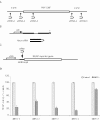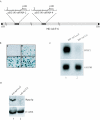A complementation method for functional analysis of mammalian genes
- PMID: 15944448
- PMCID: PMC1145195
- DOI: 10.1093/nar/gni093
A complementation method for functional analysis of mammalian genes
Abstract
Our progress in understanding mammalian gene function has lagged behind that of gene identification. New methods for mammalian gene functional analysis are needed to accelerate the process. In yeast, the powerful genetic shuffle system allows deletion of any chromosomal gene by homologous recombination and episomal expression of a mutant allele in the same cell. Here, we report a method for mammalian cells, which employs a helper-dependent adenoviral (HD-Ad) vector to synthesize small hairpin (sh) RNAs to knock-down the expression of an endogenous gene by targeting untranslated regions (UTRs). The vector simultaneously expresses an exogenous version of the same gene (wild-type or mutant allele) lacking the UTRs for functional analysis. We demonstrated the utility of the method by using PRPF3, which encodes the human RNA splicing factor Hprp3p. Recently, missense mutations in PRPF3 were found to cause autosomal-dominant Retinitis Pigmentosa, a form of genetic eye diseases affecting the retina. We knocked-down endogenous PRPF3 in multiple cell lines and rescued the phenotype (cell death) with exogenous PRPF3 cDNA, thereby creating a genetic complementation method. Because Ad vectors can efficiently transduce a wide variety of cell types, and many tissues in vivo, this method could have a wide application for gene function studies.
Figures






Similar articles
-
Mutation in the splicing factor Hprp3p linked to retinitis pigmentosa impairs interactions within the U4/U6 snRNP complex.Hum Mol Genet. 2008 Jan 15;17(2):225-39. doi: 10.1093/hmg/ddm300. Epub 2007 Oct 11. Hum Mol Genet. 2008. PMID: 17932117 Free PMC article.
-
Mutations in the pre-mRNA splicing-factor genes PRPF3, PRPF8, and PRPF31 in Spanish families with autosomal dominant retinitis pigmentosa.Invest Ophthalmol Vis Sci. 2003 May;44(5):2171-7. doi: 10.1167/iovs.02-0871. Invest Ophthalmol Vis Sci. 2003. PMID: 12714658
-
Autosomal-dominant retinitis pigmentosa caused by a mutation in SNRNP200, a gene required for unwinding of U4/U6 snRNAs.Am J Hum Genet. 2009 Nov;85(5):617-27. doi: 10.1016/j.ajhg.2009.09.020. Epub 2009 Oct 29. Am J Hum Genet. 2009. PMID: 19878916 Free PMC article.
-
Mutations in splicing factor PRPF3, causing retinal degeneration, form detrimental aggregates in photoreceptor cells.Hum Mol Genet. 2007 Jul 15;16(14):1699-707. doi: 10.1093/hmg/ddm118. Epub 2007 May 20. Hum Mol Genet. 2007. PMID: 17517693
-
When SUMO met splicing.RNA Biol. 2018;15(6):689-695. doi: 10.1080/15476286.2018.1457936. Epub 2018 May 9. RNA Biol. 2018. PMID: 29741121 Free PMC article. Review.
Cited by
-
Regulation of epithelium-specific Ets-like factors ESE-1 and ESE-3 in airway epithelial cells: potential roles in airway inflammation.Cell Res. 2008 Jun;18(6):649-63. doi: 10.1038/cr.2008.57. Cell Res. 2008. PMID: 18475289 Free PMC article.
-
Mutation in the splicing factor Hprp3p linked to retinitis pigmentosa impairs interactions within the U4/U6 snRNP complex.Hum Mol Genet. 2008 Jan 15;17(2):225-39. doi: 10.1093/hmg/ddm300. Epub 2007 Oct 11. Hum Mol Genet. 2008. PMID: 17932117 Free PMC article.
-
RNAi therapeutics: can siRNAs conquer SARS?Gene Ther. 2006 Jun;13(11):871-2. doi: 10.1038/sj.gt.3302682. Gene Ther. 2006. PMID: 17262907 Free PMC article. No abstract available.
-
Temporal and tissue specific regulation of RP-associated splicing factor genes PRPF3, PRPF31 and PRPC8--implications in the pathogenesis of RP.PLoS One. 2011 Jan 19;6(1):e15860. doi: 10.1371/journal.pone.0015860. PLoS One. 2011. PMID: 21283520 Free PMC article.
References
-
- Lander E.S., Linton L.M., Birren B., Nusbaum C., Zody M.C., Baldwin J., Devon K., Dewar K., Doyle M., FitzHugh W., et al. Initial sequencing and analysis of the human genome. Nature. 2001;409:860–921. - PubMed
-
- Venter J.C., Adams M.D., Myers E.W., Li P.W., Mural R.J., Sutton G.G., Smith H.O., Yandell M., Evans C.A., Holt R.A., et al. The sequence of the human genome. Science. 2001;291:1304–1351. - PubMed
-
- Shoemaker D.D., Schadt E.E., Armour C.D., He Y.D., Garrett-Engele P., McDonagh P.D., Loerch P.M., Leonardson A., Lum P.Y., Cavet G., et al. Experimental annotation of the human genome using microarray technology. Nature. 2001;409:922–927. - PubMed
-
- Shi Y. Mammalian RNAi for the masses. Trends Genet. 2003;19:9–12. - PubMed
Publication types
MeSH terms
Substances
Grants and funding
LinkOut - more resources
Full Text Sources
Other Literature Sources

